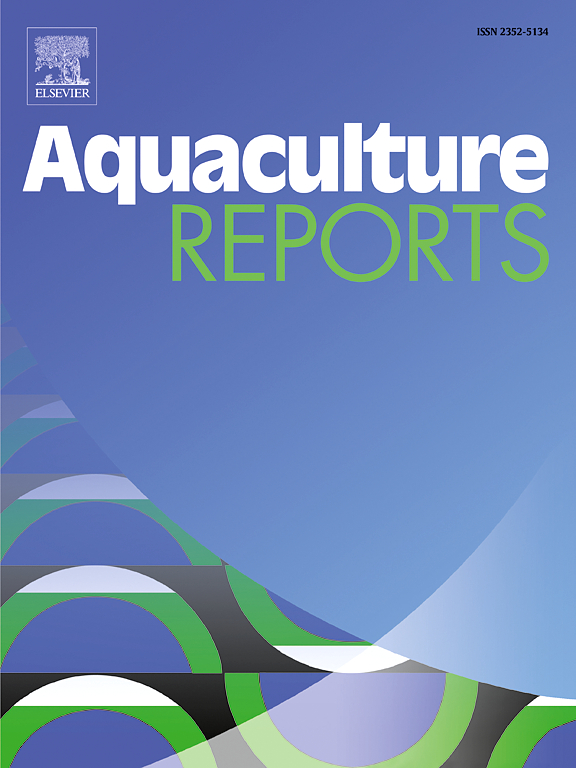Identification of candidate pheromones and neurotransmitter regulation of agonistic behavior in Macrobrachium rosenbergii
IF 3.7
2区 农林科学
Q1 FISHERIES
引用次数: 0
Abstract
Macrobrachium rosenbergii, a crucial commercial prawn species in China, exhibits agonistic behavior under high-density culture conditions, which negatively impacts their integrity, survival, and growth, causing economic losses. This study utilized liquid chromatography mass spectrometry (LC-MS) to identify and classify the metabolic differences in urine and water mixtures of M. rosenbergii displaying agonistic behavior versus those without. Seventeen compounds, such as 4-Acetamidobutyric acid, 1-oleoyl-2-myristoyl-sn-glycero-3-phosphocholine, N-Acety-L-valine, 11-Dehydrocorticosterone, Sphinganine (Sph t18:0), and Acitretin, were identified as candidate pheromones associated with agonistic behavior, 4-Acetamidobutyric acid and Sph (t18:0) were hypothesized to be particularly significant. Additionally, the roles of serotonin (5-HT) and dopamine (DA) in agonistic behavior among M. rosenbergii males were evaluated. We found that 5-HT levels in hemolymph significantly decreased after fighting (P < 0.05), while DA levels significantly increased (P < 0.05) compared to the control group. The receptor genes of 5-HT and DA (5-HTRs and DARs) were further analyzed. Gene expression analyses of M. rosenbergii before and after agonistic behavior revealed that Mr5-HTR1 exhibited significant changes in hemolymph and abdominal ganglia, while Mr5-HTR2 varied across five tissues, and MrDAR1 and MrDAR2 showed significant changes in the brain and abdominal ganglia. To verify the impact of 5-HTRs on the agonistic behavior, 5-HTRs agonist and antagonist were in vivo injected. The results showed that the injection of 5-HTRs agonists significantly inhibited the occurrence of agonistic behavior in M. rosenbergii. This study deepens our understanding of the regulatory mechanisms of crustacean agonistic behavior and provides a theoretical basis for improving the crustacean farming management.
罗氏沼虾拮抗行为的候选信息素鉴定及神经递质调控
罗氏沼虾(Macrobrachium rosenbergii)是中国重要的商业对虾品种,高密度养殖条件下,罗氏沼虾表现出拮抗行为,影响了其完整性、生存和生长,造成经济损失。本研究利用液相色谱-质谱(LC-MS)来鉴定和分类具有激动作用行为的罗氏分枝杆菌与没有激动作用行为的罗氏分枝杆菌在尿液和水中混合物中的代谢差异。17种化合物,如4-乙酰氨基丁酸、1-油基-2-肉豆油基- cn -甘油-3-磷胆碱、n-乙酰- l-缬氨酸、11-脱氢皮质酮、鞘氨酸(Sph t18:0)和阿维黄素,被确定为与激动行为相关的候选信息素,其中4-乙酰氨基丁酸和Sph (t18:0)被认为是特别重要的。此外,我们还评估了血清素(5-HT)和多巴胺(DA)在雄性罗氏m.r onbergii激动行为中的作用。我们发现,与对照组相比,战斗后血淋巴中5-HT水平显著降低(P <; 0.05),而DA水平显著升高(P <; 0.05)。进一步分析5-HT和DA受体基因(5-HTRs和dar)。罗氏m.r onbergii激动行为前后的基因表达分析显示,Mr5-HTR1在血淋巴和腹部神经节中表现出显著变化,Mr5-HTR2在5个组织中存在差异,MrDAR1和MrDAR2在大脑和腹部神经节中表现出显著变化。为了验证5-HTRs对激动行为的影响,我们在体内注射了5-HTRs的激动剂和拮抗剂。结果表明,注射5-HTRs激动剂可显著抑制罗氏m.b robergii激动行为的发生。本研究加深了我们对甲壳类动物拮抗行为调控机制的认识,为改进甲壳类动物养殖管理提供了理论依据。
本文章由计算机程序翻译,如有差异,请以英文原文为准。
求助全文
约1分钟内获得全文
求助全文
来源期刊

Aquaculture Reports
Agricultural and Biological Sciences-Animal Science and Zoology
CiteScore
5.90
自引率
8.10%
发文量
469
审稿时长
77 days
期刊介绍:
Aquaculture Reports will publish original research papers and reviews documenting outstanding science with a regional context and focus, answering the need for high quality information on novel species, systems and regions in emerging areas of aquaculture research and development, such as integrated multi-trophic aquaculture, urban aquaculture, ornamental, unfed aquaculture, offshore aquaculture and others. Papers having industry research as priority and encompassing product development research or current industry practice are encouraged.
 求助内容:
求助内容: 应助结果提醒方式:
应助结果提醒方式:


